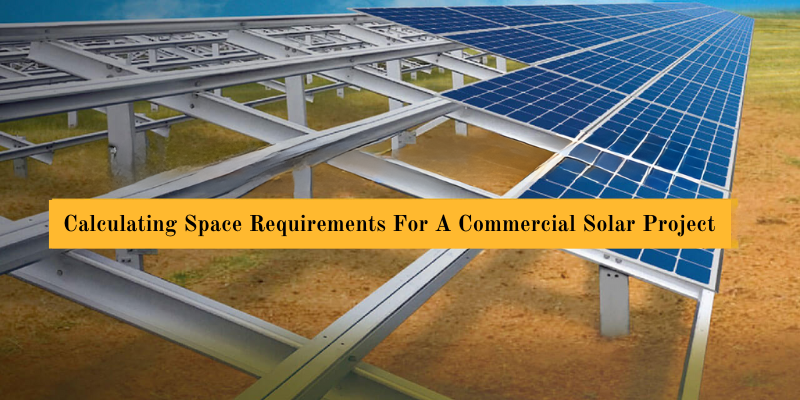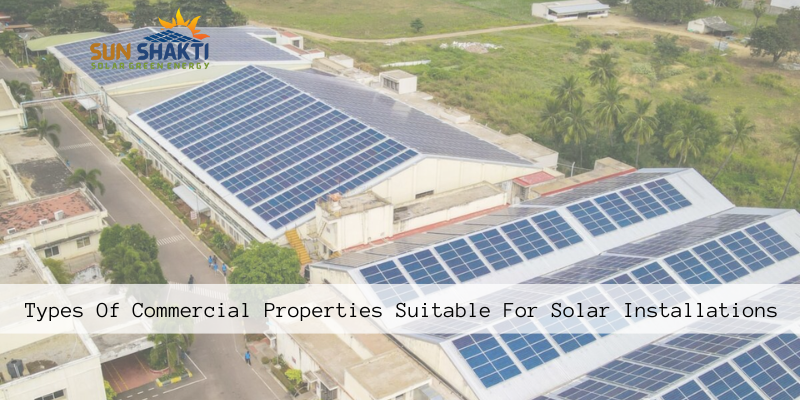Solar power is a popular alternative for commercial projects as they seek sustainable and affordable energy. Solar panel space is a major concern for organisations considering it. Space requirements depend on energy needs, panel type, and property layout. For Jaipur businesses, consulting with top solar companies in Jaipur or solar installation companies in Jaipur can help choose the best solar panel space.
This tutorial explains how to calculate commercial solar installation area, including rooftop and ground-mounted alternatives, and what to expect when designing a solar project.
Understanding The Basics: How Space Affects Solar Panel Efficiency
Space plays a key role in figuring out how efficient and productive a commercial solar project can be. A standard commercial solar panel is roughly 18 square feet in size and can produce around 400 watts, though this can vary based on the panel type, where it’s located, and how much sunlight it gets. But it’s not only the panel size that counts—things like arrangement, shading, roof tilt, and panel orientation are also really important in figuring out the final space you’ll need.
Factors Influencing Space Requirements for Commercial Solar Panels
Energy Goals and System Size
- The main thing that decides how big the system needs to be is how much electricity a business wants to generate. Commercial buildings usually need bigger systems because they have high energy demands.
- Usually, you need about 100 square feet of space for 1 kW of solar power. If your business requires a 100 kW system to cover its energy needs, you’re looking at needing around 10,000 square feet for the panels.
Type of Solar Panel Used
- Monocrystalline Panels: Monocrystalline panels are pretty efficient and generate more electricity for each square foot. They’re perfect for buildings that don’t have much rooftop space.
- Polycrystalline Panels: They’re a bit less efficient and need more space to generate the same amount of electricity as monocrystalline panels.
- Thin-Film Panels: Thin-film panels are commonly found on large, flat rooftops. They might not be the most efficient option out there, but their lightweight design makes them a popular choice. Just keep in mind, they do need quite a bit of space for each kilowatt of power they produce.
Roof Shape and Orientation
- Flat Roofs: Flat commercial roofs are great for solar panels, particularly for businesses that want the flexibility to adjust the direction of the panels.
- Sloped Roofs: For the best exposure, sloped roofs should have panels facing south if you’re in the northern hemisphere. These setups might restrict how many panels you can put up.
- Orientation and Tilt Angle: The best tilt angle for solar panels usually matches the latitude of where they’re installed. If the tilt isn’t quite right or if the panels are facing east or west instead of south, you might need more panels to get enough energy.
Ground-Mounted vs. Rooftop Installations
- Rooftop Systems: There’s only so much room on the roof for panels, but you know, rooftops are usually just sitting there, waiting to be put to good use for solar energy.
- Ground-Mounted Systems: If you’ve got plenty of land, ground-mounted systems could be a fantastic choice for your business. They usually need a bit more room for each panel because of the spacing needed for maintenance and sunlight access.
Calculating Space Requirements For A Commercial Solar Project

A basic calculation combining predicted energy output and panel efficiency can estimate commercial solar installation space. The process is as follows:
- Determine Energy Requirements
Figure out how much energy your business typically uses, which is usually measured in kilowatt-hours (kWh) each year. Your solar provider can help you figure out the right system size in kW to meet your needs. - Estimate System Size and Panel Count
After determining your energy needs, consult a solar installation company in Jaipur to select kW system size. If your business needs 100 kW, you may need 250 400-watt panels. - Calculate Required Space Based on Panel Type
Just take the number of panels and multiply it by the space that each one needs. So, if each panel takes up 18 square feet and you’re looking at 250 panels, you’re going to need around 4,500 square feet for the whole installation. The number could go up based on things like how far apart the rows are, any shading factors, and the way the panels are orientated.
Types Of Commercial Properties Suitable For Solar Installations

- Industrial Warehouses
- Large industrial warehouses with broad roofs are excellent for Commercial Rooftop Solar Solutions. Flat roofs make installation easier and enabling large solar arrays to fulfil high energy needs.
- Office Buildings
- Office buildings tend to use a lot of electricity, particularly when it comes to their HVAC systems. Even if you have a small rooftop, solar panels can really help cover a good chunk of the building’s energy needs.
- Parking Lots (Carports)
- Putting solar panels on carports is a smart way to make the most of parking spaces. Solar carports are a great way to keep vehicles shaded while also producing energy. They can really help businesses that don’t have much rooftop or land space to increase their energy output.
- Agricultural Land
- Ground-mounted panels are ideal for businesses with open terrain. These systems offer panel orientation flexibility for Industrial Solar Power Solutions in Jaipur.
- Retail Centers
- Retailers with flat roofs benefit from solar panels. Commercial Solar Solutions Service maximises space and lowers utility costs for these projects.
Also Read: 20kw Solar System Cost In Jaipur: Everything You Need To Know
Sample Space Requirements Table
| System Size (kW) | Approximate Space Needed (sq. ft.) | Type of Panel | Ideal Usage |
| 50 kW | 5,000 | Monocrystalline | Small commercial or retail properties |
| 100 kW | 10,000 | Polycrystalline or Thin-Film | Medium-sized office buildings |
| 250 kW | 25,000 | Monocrystalline | Large warehouses or industrial sites |
| 500 kW | 50,000 | Thin-Film (ground-mounted) | Agricultural land or large parking areas |
Considerations For Ground-Mounted Solar Projects
If you have commercial land available, ground-mounted solar panels can really help you get the most out of your energy production. Let’s think about a few more things:
- Land Area and Spacing
Ground-mounted systems usually require some extra space between the rows to avoid shading between the panels. They need roughly 3 to 5 acres for each megawatt of solar capacity. - Accessibility and Maintenance
Having some space in ground-mounted systems really helps with maintenance, and that can boost how long the system lasts and how well it works. Keeping up with regular maintenance is super important to make sure the panels stay clear of dust and debris. - Dual-Use Land Opportunities
In agricultural areas, some ground-mounted systems can actually work well with crop production or livestock grazing, making the most out of the land we have.

Maximizing Solar Efficiency In Limited Spaces
If you’ve got a commercial property with limited space, there are definitely some strategies to boost the efficiency of your solar panels:
- Choose High-Efficiency Panels: Monocrystalline panels are great because they can produce more energy while taking up less space, making them perfect for smaller rooftops.
- Optimize Tilt and Orientation: When you angle the panels just right, they soak up more sunlight, which means you won’t need as many to cover your energy needs.
- Use Tracking Systems: Ground-mounted solar tracking devices may follow the sun’s path to absorb more energy throughout the day, but they take up more area.
Benefits Of Partnering With Jaipur Solar Solutions
Teaming up with experts in commercial solar solutions can really help businesses get the most energy output possible. Solar EPC Service In Jaipur, such as Sun Shakti Solar, focus on creating systems that enhance efficiency and make the most of the space they have to work with. Businesses in Jaipur can really benefit from clean energy with custom services designed for both rooftop and ground-mounted systems.
Also Read: The Benefits Of Solar Energy For Hotels: A Guide To Savings And Sustainability
Conclusion
Space needs are very important for business solar projects to succeed. By thinking about their energy needs, panel types, and space, businesses can make the best use of their land layout and meet their electricity needs with solar installation. Planning how your solar panels will be set up will help you save the most energy, no matter if you have a small office roof or a big industrial site.
As an excellent investment for business properties, solar energy saves a lot of money and is good for the environment. Businesses can get high-quality industrial solar power solutions in Jaipur that fit their needs by working with experienced solar companies in Jaipur. This makes the business more environmentally friendly and cuts down on running costs.
Quick Contact Us
Call/WhatsApp: +91-8432558555, +91-9667029285
Email: info.sunshaktisolar@gmail.com
Visit: https://sunshaktisolar.com
FAQs
- What is the minimum space required for a commercial solar panel installation?
Average solar electricity requires 100 square feet per kW. Example: A 100 kW system requires 10,000 square feet. However, panel type and roof direction may affect space needs. - How much space is needed for a 500 kW solar project?
A 500 kW system usually needs around 50,000 square feet, but that can vary based on things like panel efficiency, shading, and how everything is laid out. When it comes to ground-mounted systems, you might want to consider adding some extra space between the rows. This helps with maintenance and ensures they get enough sunlight. - Which types of commercial buildings are best for rooftop solar panels?
Rooftop solar installations work great on large industrial warehouses, retail centers with flat roofs, and office buildings that have open rooftop space. Parking lots can actually be great for adding solar carports, serving two purposes at once! - Is ground-mounted or rooftop solar better for commercial projects?
Both options come with their perks: rooftop systems utilize that extra roof space you might have, while ground-mounted systems are great for businesses with some land to spare. They offer more flexibility in placement and make maintenance a breeze. - How can I maximize solar efficiency in limited rooftop space?
If you want to get the most energy from smaller rooftops, think about using high-efficiency panels like monocrystalline, adjusting the panel tilt, and maybe even looking into solar tracking systems.

